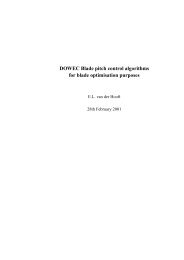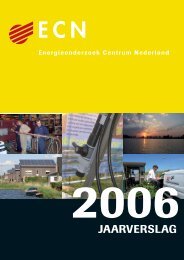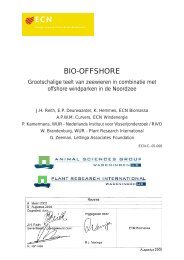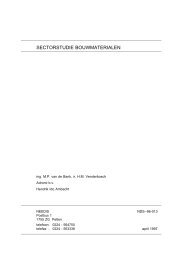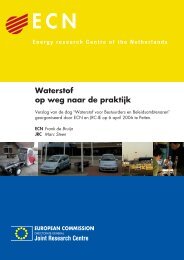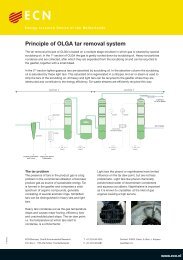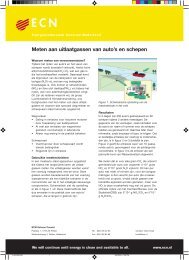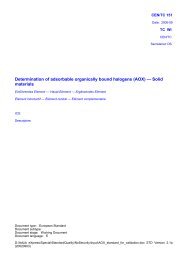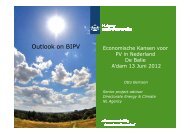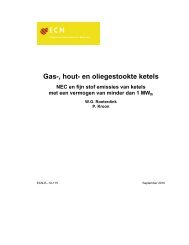PDF format (503 kB) - ECN
PDF format (503 kB) - ECN
PDF format (503 kB) - ECN
You also want an ePaper? Increase the reach of your titles
YUMPU automatically turns print PDFs into web optimized ePapers that Google loves.
ogy for igniting the engine, valve steering management, turbo-charging, direct fuel injection, electronic<br />
engine control etc. The term improved internal combustion engine combines the relevant options for both<br />
diesel and petrol vehicles.<br />
Improved tires and aerodynamics offer small savings, but they are also relatively easy to implement. Continuous<br />
variable transmission offers a continuous range of gears to be used. In this way, the engine use is<br />
optimised, resulting in a higher fuel economy of the vehicle. The modified frame comprises all material<br />
substitution options to reduce the vehicle weight. Light weight construction of vehicles is interesting, because<br />
it improves vehicle economy. The most common material in the passenger car is steel, which has a<br />
high density. Substituting a volume unit of steel by lower density materials results in a weight advantage.<br />
Material substitution is not very easy, since a great diversity of requirements is demanded from the construction<br />
material, and steel adequately fulfils most of these requirements. For example, the construction in<br />
aluminium (density about 1/3 of steel) requires thicker parts, as the strength of aluminium is lower than the<br />
steel strength. Material substitution can follow several directions. Generally, new high strength steel alloys,<br />
aluminium and plastics are the most common materials. An extensive review of the possibilities of each of<br />
these materials pointed out aluminium as the most promising (Bouwman and Moll, 1997).<br />
2. Options emphasising infrastructural change<br />
This category comprises the alternative fuel vehicles. The adaptations to be made in this situation are not<br />
individual, but require changes in the infrastructure resulting from the distribution of new fuels. This category<br />
includes the introduction of the electric vehicle, the hybrid vehicle and the fuel cell passenger car.<br />
An electric vehicle is powered by a large battery. The energy use of electric vehicles is very low compared<br />
to the standard internal combustion vehicles. However, large ERE-values for the generation of electricity<br />
(1.7 MJ/MJ in the Europe in 1990) cause a relatively large primary energy demand for electric vehicles.<br />
Electric vehicles are equipped with regenerative braking (RB), a system that stores braking energy. The<br />
hybrid passenger car combines the advantages of both an internal combustion engine (unlimited range) and<br />
electric propulsion (low emissions and noise). Hybrid passenger cars use the electric part in urban traffic<br />
and change to the standard engine when a long range is required. The disadvantage of this system is the<br />
relatively high vehicle weight due to the combination of the two systems. This results in a higher energy<br />
use when driving in the internal combustion configuration compared to the standard vehicle.<br />
A fuel cell passenger car also runs on electricity, but uses fuel which is converted directly into electricity in<br />
the car. The technology is not yet very mature. No vehicles with fuel cell technology are on the market yet.<br />
Implementation before 2020 is highly uncertain, and at present the costs associated with this technology<br />
are very high.<br />
3. Options emphasising behavioural change<br />
These options require important behavioural adaptations. Examples cannot be found in the database used<br />
for the technological options. This category comprises a change in modal split (increased use of public<br />
transport), increased vehicle life, driving small passenger cars and increasing the average occupancy rate<br />
of passenger cars. These category 3 improvement options require societal adaptations. The infrastructural<br />
options are assumed to be easier to implement, as the necessary changes can be influenced with policy<br />
more directly.<br />
For the change of the modal split, it is assumed that the share of public transport in passenger mobility<br />
doubles from 14% to 28% by 2020. This implies that this option is only valid for a small share in the total<br />
mobility demand. Replacing a passenger car kilometre by a public transport kilometre has an average energy<br />
advantage of 61% in 2020 and 73% in 2050, compared to the 1990 value (reconstructed out of Ybema<br />
et al., 1994; Schol and Ybema, 1998). Increasing the vehicle life from 12.5 to 15 years affects the indirect<br />
energy component. Doing so requires major maintenance investments from the various users of a car. The<br />
effects of a longer lifetime are not very large. The gain from dividing the production energy of the vehicle<br />
(15% of the lifetime energy (Moll and Kramer, 1996)) over a larger number of kilometres is partly lost by<br />
the need for increased maintenance which has an energy requirement of 2 GJ/a (Moll and Kramer, 1996).



